曼昆经济学原理答案30—34
- 格式:doc
- 大小:3.99 MB
- 文档页数:79
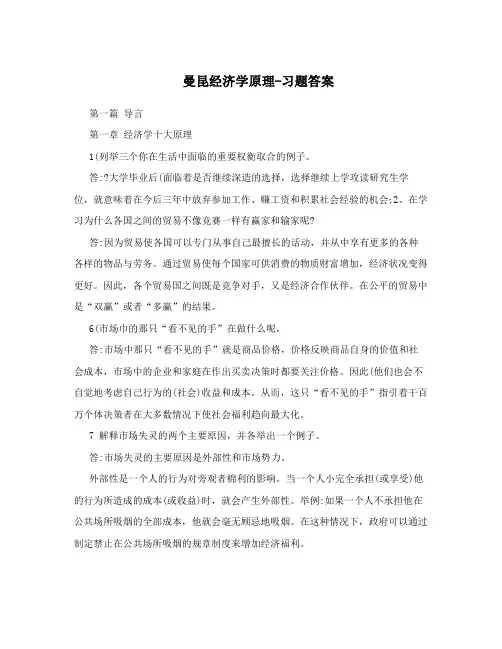
曼昆经济学原理-习题答案第一篇导言第一章经济学十大原理1(列举三个你在生活中面临的重要权衡取合的例子。
答:?大学毕业后(面临着是否继续深造的选择,选择继续上学攻读研究生学位,就意味着在今后三年中放弃参加工作、赚工资和积累社会经验的机会;2、在学习为什么各国之间的贸易不像竞赛一样有赢家和输家呢?答:因为贸易使各国可以专门从事自己最擅长的话动,并从中享有更多的各种各样的物品与劳务。
通过贸易使每个国家可供消费的物质财富增加,经济状况变得更好。
因此,各个贸易国之间既是竞争对手,又是经济合作伙伴。
在公平的贸易中是“双赢”或者“多赢”的结果。
6(市场巾的那只“看不见的手”在做什么呢,答:市场中那只“看不见的手”就是商品价格,价格反映商品自身的价值和社会成本,市场中的企业和家庭在作出买卖决策时都要关注价格。
因此(他们也会不自觉地考虑自己行为的(社会)收益和成本。
从而,这只“看不见的手”指引着干百万个体决策者在大多数情况下使社会福利趋向最大化。
7 解释市场失灵的两个主要原因,并各举出一个例子。
答:市场失灵的主要原因是外部性和市场势力。
外部性是一个人的行为对旁观者棉利的影响。
当一个人小完全承担(或享受)他的行为所造成的成本(或收益)时,就会产生外部性。
举例:如果一个人不承担他在公共场所吸烟的全部成本,他就会毫无顾忌地吸烟。
在这种情况下,政府可以通过制定禁止在公共场所吸烟的规章制度来增加经济福利。
市场势力是指一个人(或一小群人)不适当地影响市场价格的能力。
例如:某种商品的垄断生产者由于几乎不受市场竞争的影响,可以向消费者收取过高的垄断价格。
在这种情况下,规定垄断者收取的价格有可能提高经济效率。
8(为什么生产率是重要的?答:因为一国的生活水平取决于它生产物品与劳务的能力,而对这种能力的最重要的衡量度就是生产率。
生产率越高,一国生产的物品与劳务量就越多。
9什么是通货膨胀,什么引起了通货膨胀?答:通货膨胀是流通中货币量的增加而造成的货币贬值生活中价格总水平上升。
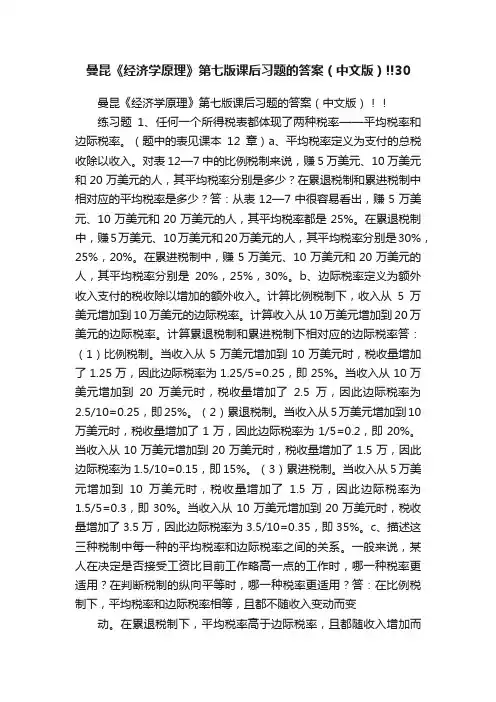
曼昆《经济学原理》第七版课后习题的答案(中文版)!!30曼昆《经济学原理》第七版课后习题的答案(中文版)!!练习题1、任何一个所得税表都体现了两种税率——平均税率和边际税率。
(题中的表见课本12章)a、平均税率定义为支付的总税收除以收入。
对表12—7中的比例税制来说,赚5万美元、10万美元和20万美元的人,其平均税率分别是多少?在累退税制和累进税制中相对应的平均税率是多少?答:从表12—7中很容易看出,赚5万美元、10万美元和20万美元的人,其平均税率都是25%。
在累退税制中,赚5万美元、10万美元和20万美元的人,其平均税率分别是30%,25%,20%。
在累进税制中,赚5万美元、10万美元和20万美元的人,其平均税率分别是20%,25%,30%。
b、边际税率定义为额外收入支付的税收除以增加的额外收入。
计算比例税制下,收入从5万美元增加到10万美元的边际税率。
计算收入从10万美元增加到20万美元的边际税率。
计算累退税制和累进税制下相对应的边际税率答:(1)比例税制。
当收入从5万美元增加到10万美元时,税收量增加了1.25万,因此边际税率为1.25/5=0.25,即25%。
当收入从10万美元增加到20万美元时,税收量增加了2.5万,因此边际税率为2.5/10=0.25,即25%。
(2)累退税制。
当收入从5万美元增加到10万美元时,税收量增加了1万,因此边际税率为1/5=0.2,即20%。
当收入从10万美元增加到20万美元时,税收量增加了1.5万,因此边际税率为1.5/10=0.15,即15%。
(3)累进税制。
当收入从5万美元增加到10万美元时,税收量增加了1.5万,因此边际税率为1.5/5=0.3,即30%。
当收入从10万美元增加到20万美元时,税收量增加了3.5万,因此边际税率为3.5/10=0.35,即35%。
c、描述这三种税制中每一种的平均税率和边际税率之间的关系。
一般来说,某人在决定是否接受工资比目前工作略高一点的工作时,哪一种税率更适用?在判断税制的纵向平等时,哪一种税率更适用?答:在比例税制下,平均税率和边际税率相等,且都不随收入变动而变动。
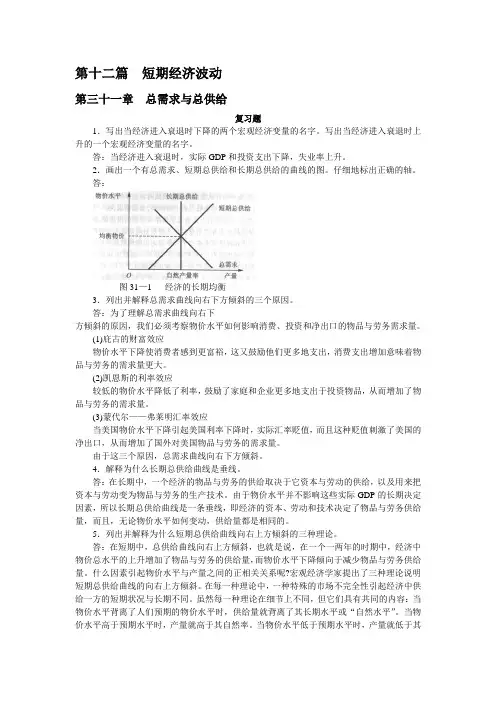
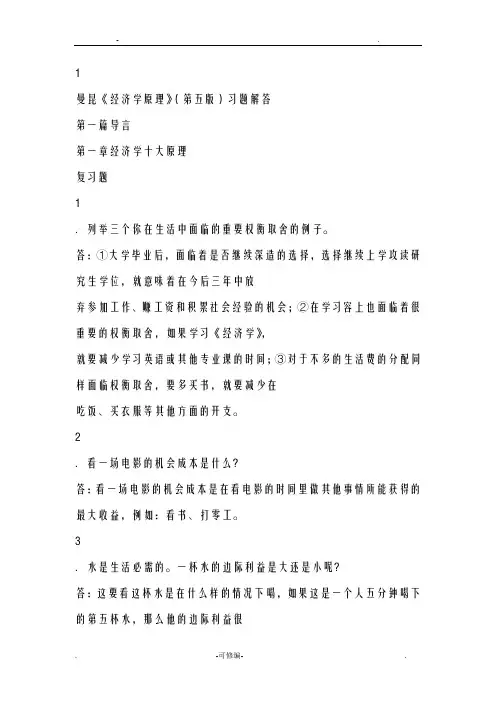
1曼昆《经济学原理》(第五版)习题解答第一篇导言第一章经济学十大原理复习题1.列举三个你在生活中面临的重要权衡取舍的例子。
答:①大学毕业后,面临着是否继续深造的选择,选择继续上学攻读研究生学位,就意味着在今后三年中放弃参加工作、赚工资和积累社会经验的机会;②在学习容上也面临着很重要的权衡取舍,如果学习《经济学》,就要减少学习英语或其他专业课的时间;③对于不多的生活费的分配同样面临权衡取舍,要多买书,就要减少在吃饭、买衣服等其他方面的开支。
2.看一场电影的机会成本是什么?答:看一场电影的机会成本是在看电影的时间里做其他事情所能获得的最大收益,例如:看书、打零工。
3.水是生活必需的。
一杯水的边际利益是大还是小呢?答:这要看这杯水是在什么样的情况下喝,如果这是一个人五分钟喝下的第五杯水,那么他的边际利益很小,有可能为负;如果这是一个极度干渴的人喝下的第一杯水,那么他的边际利益将会极大。
4.为什么决策者应该考虑激励?答:因为人们会对激励做出反应,而政策会影响激励。
如果政策改变了激励,它将使人们改变自己的行为,当决策者未能考虑到行为如何由于政策的原因而变化时,他们的政策往往会产生意想不到的效果。
5.为什么各国之间的贸易不像一场比赛一样有赢家和输家呢?答:因为贸易使各国可以专门从事自己最擅长的活动,并从中享有更多的各种各样的物品与劳务。
通过贸易使每个国家可供消费的物质财富增加,经济状况变得更好。
因此,各个贸易国之间既是竞争对手,又是经济合作伙伴。
在公平的贸易中是“双赢”或者“多赢”的结果。
6.市场中的那只“看不见的手”在做什么呢?答:市场中那只“看不见的手”就是商品价格,价格反映商品自身的价值和社会成本,市场中的企业和家庭在作出买卖决策时都要关注价格。
因此,他们也会不自觉地考虑自己行为的(社会)收益和成本。
从而,这只“看不见的手”指引着千百万个体决策者在大多数情况下使社会福利趋向最大化。
7.解释市场失灵的两个主要原因,并各举出一个例子。
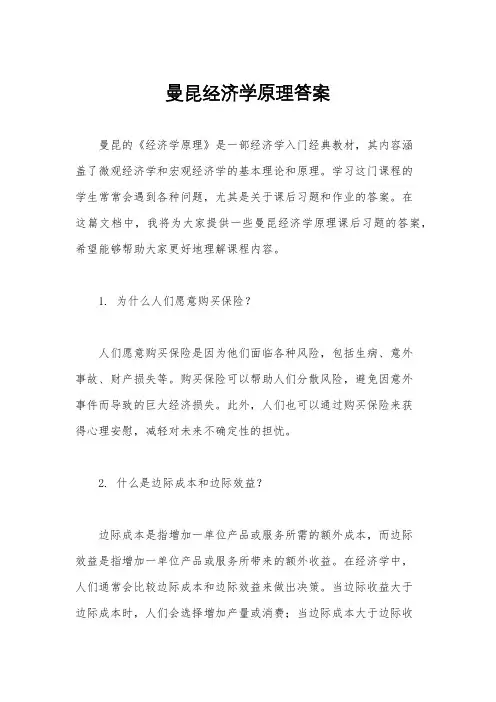
曼昆经济学原理答案曼昆的《经济学原理》是一部经济学入门经典教材,其内容涵盖了微观经济学和宏观经济学的基本理论和原理。
学习这门课程的学生常常会遇到各种问题,尤其是关于课后习题和作业的答案。
在这篇文档中,我将为大家提供一些曼昆经济学原理课后习题的答案,希望能够帮助大家更好地理解课程内容。
1. 为什么人们愿意购买保险?人们愿意购买保险是因为他们面临各种风险,包括生病、意外事故、财产损失等。
购买保险可以帮助人们分散风险,避免因意外事件而导致的巨大经济损失。
此外,人们也可以通过购买保险来获得心理安慰,减轻对未来不确定性的担忧。
2. 什么是边际成本和边际效益?边际成本是指增加一单位产品或服务所需的额外成本,而边际效益是指增加一单位产品或服务所带来的额外收益。
在经济学中,人们通常会比较边际成本和边际效益来做出决策。
当边际收益大于边际成本时,人们会选择增加产量或消费;当边际成本大于边际收益时,则会选择减少产量或消费。
3. 为什么需求曲线向下倾斜?需求曲线向下倾斜的原因主要包括收入效应和替代效应。
当产品价格下降时,消费者的实际购买力增加,导致需求量增加,这就是收入效应。
另外,当产品价格下降时,消费者更倾向于购买价格更低的替代品,从而导致对该产品的需求增加,这就是替代效应。
因此,需求曲线向下倾斜是由这两种效应共同作用的结果。
4. 什么是弹性需求?弹性需求是指产品需求量对价格变化的敏感程度。
当需求量对价格变化非常敏感时,我们称之为弹性需求;反之,当需求量对价格变化不太敏感时,我们称之为非弹性需求。
弹性需求可以帮助企业和政府更好地预测市场变化,制定合理的价格和税收政策。
5. 为什么垄断市场下的价格高于竞争市场?在垄断市场中,由于只有一个卖家或者买家,市场上不存在竞争,卖家可以通过控制价格来获得更高的利润。
而在竞争市场中,存在多个卖家和买家,价格受到市场竞争的影响,因此价格相对较低。
这就是为什么垄断市场下的价格通常高于竞争市场的原因。
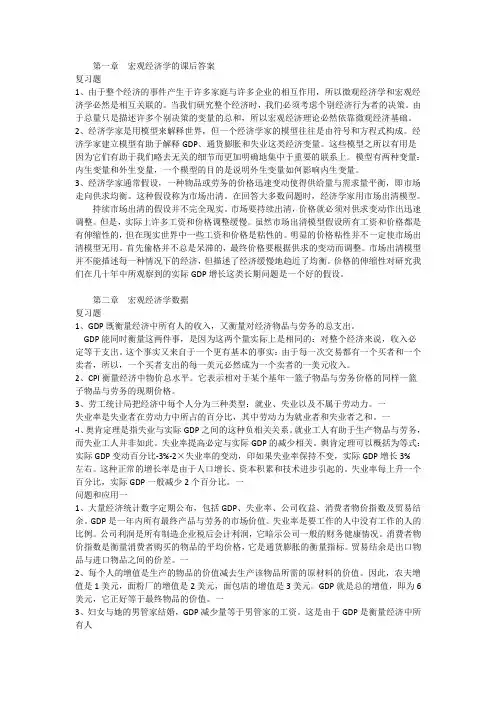
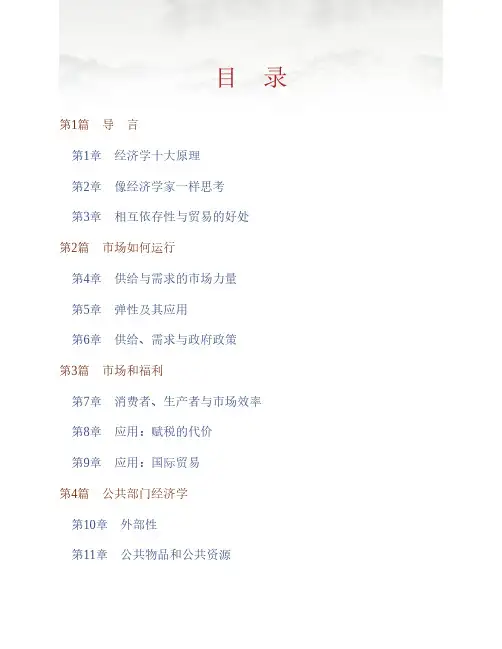
目 录第1篇 导 言第1章 经济学十大原理第2章 像经济学家一样思考第3章 相互依存性与贸易的好处第2篇 市场如何运行第4章 供给与需求的市场力量第5章 弹性及其应用第6章 供给、需求与政府政策第3篇 市场和福利第7章 消费者、生产者与市场效率第8章 应用:赋税的代价第9章 应用:国际贸易第4篇 公共部门经济学第10章 外部性第11章 公共物品和公共资源第12章 税制的设计第5篇 企业行为与产业组织第13章 生产成本第14章 竞争市场上的企业第15章 垄 断第16章 垄断竞争第17章 寡 头第6篇 劳动市场经济学第18章 生产要素市场第19章 收入与歧视第20章 收入不平等与贫困第7篇 深入研究的论题第21章 消费者选择理论第22章 微观经济学前沿第1篇 导 言第1章 经济学十大原理一、概念题1.稀缺性(scarcity)答:经济学研究的问题和经济物品都是以稀缺性为前提的。
稀缺性指在给定的时间内,相对于人的需求而言,经济资源的供给总是不足的,也就是资源的有用性与有限性。
人类消费各种物品的欲望是无限的,满足这种欲望的物品,有的可以不付出任何代价而随意取得,称之为自由物品,如阳光和空气;但绝大多数物品是不能自由取用的,因为世界上的资源(包括物质资源和人力资源)是有限的,这种有限的、为获取它必须付出某种代价的物品,称为“经济物品”。
正因为稀缺性的客观存在,地球上就存在着资源的有限性和人类的欲望与需求的无限性之间的矛盾。
经济学的一个重要研究任务就是:“研究人们如何进行抉择,以便使用稀缺的或有限的生产性资源(土地、劳动、资本品如机器、技术知识)来生产各种商品,并把它们分配给不同的社会成员进行消费。
”也就是从经济学角度来研究使用有限的资源来生产什么、如何生产和为谁生产的问题。
2.经济学(economics)答:经济学是研究如何将稀缺的资源有效地配置给相互竞争的用途,以使人类的欲望得到最大限度满足的科学。
时下经常见诸国内报刊文献的“现代西方经济学”一词,大多也都在这个意义上使用。
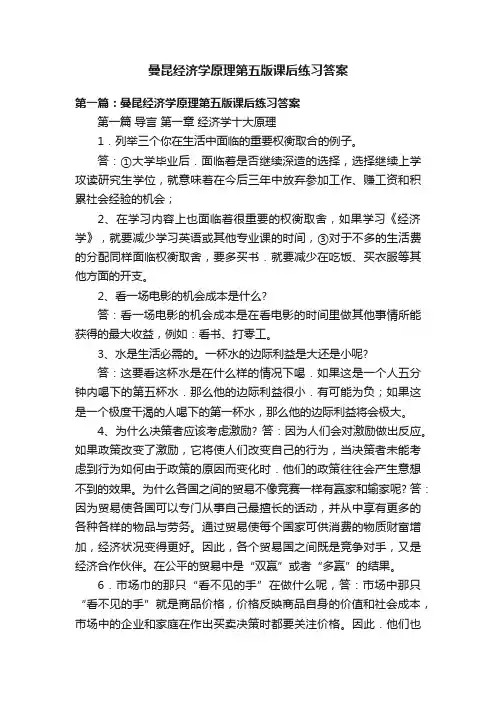
曼昆经济学原理第五版课后练习答案第一篇:曼昆经济学原理第五版课后练习答案第一篇导言第一章经济学十大原理1.列举三个你在生活中面临的重要权衡取合的例子。
答:①大学毕业后.面临着是否继续深造的选择,选择继续上学攻读研究生学位,就意味着在今后三年中放弃参加工作、赚工资和积累社会经验的机会;2、在学习内容上也面临着很重要的权衡取舍,如果学习《经济学》,就要减少学习英语或其他专业课的时间,③对于不多的生活费的分配同样面临权衡取舍,要多买书.就要减少在吃饭、买衣服等其他方面的开支。
2、看一场电影的机会成本是什么?答:看一场电影的机会成本是在看电影的时间里做其他事情所能获得的最大收益,例如:看书、打零工。
3、水是生活必需的。
一杯水的边际利益是大还是小呢?答:这要看这杯水是在什么样的情况下喝.如果这是一个人五分钟内喝下的第五杯水.那么他的边际利益很小.有可能为负;如果这是一个极度干渴的人喝下的第一杯水,那么他的边际利益将会极大。
4、为什么决策者应该考虑激励? 答:因为人们会对激励做出反应。
如果政策改变了激励,它将使人们改变自己的行为,当决策者未能考虑到行为如何由于政策的原因而变化时.他们的政策往往会产生意想不到的效果。
为什么各国之间的贸易不像竞赛一样有赢家和输家呢? 答:因为贸易使各国可以专门从事自己最擅长的话动,并从中享有更多的各种各样的物品与劳务。
通过贸易使每个国家可供消费的物质财富增加,经济状况变得更好。
因此,各个贸易国之间既是竞争对手,又是经济合作伙伴。
在公平的贸易中是“双赢”或者“多赢”的结果。
6.市场巾的那只“看不见的手”在做什么呢,答:市场中那只“看不见的手”就是商品价格,价格反映商品自身的价值和社会成本,市场中的企业和家庭在作出买卖决策时都要关注价格。
因此.他们也会不自觉地考虑自己行为的(社会)收益和成本。
从而,这只“看不见的手”指引着干百万个体决策者在大多数情况下使社会福利趋向最大化。
解释市场失灵的两个主要原因,并各举出一个例子。
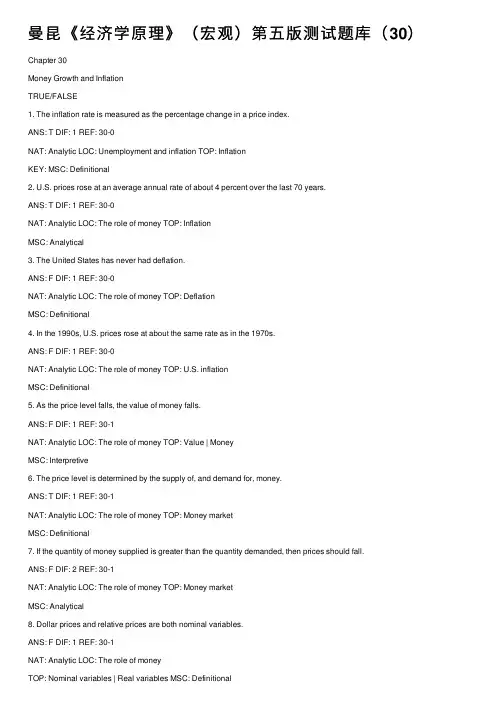
曼昆《经济学原理》(宏观)第五版测试题库(30)Chapter 30Money Growth and InflationTRUE/FALSE1. The inflation rate is measured as the percentage change in a price index.ANS: T DIF: 1 REF: 30-0NAT: Analytic LOC: Unemployment and inflation TOP: InflationKEY: MSC: Definitional2. U.S. prices rose at an average annual rate of about 4 percent over the last 70 years.ANS: T DIF: 1 REF: 30-0NAT: Analytic LOC: The role of money TOP: InflationMSC: Analytical3. The United States has never had deflation.ANS: F DIF: 1 REF: 30-0NAT: Analytic LOC: The role of money TOP: DeflationMSC: Definitional4. In the 1990s, U.S. prices rose at about the same rate as in the 1970s.ANS: F DIF: 1 REF: 30-0NAT: Analytic LOC: The role of money TOP: U.S. inflationMSC: Definitional5. As the price level falls, the value of money falls.ANS: F DIF: 1 REF: 30-1NAT: Analytic LOC: The role of money TOP: Value | MoneyMSC: Interpretive6. The price level is determined by the supply of, and demand for, money.ANS: T DIF: 1 REF: 30-1NAT: Analytic LOC: The role of money TOP: Money marketMSC: Definitional7. If the quantity of money supplied is greater than the quantity demanded, then prices should fall.ANS: F DIF: 2 REF: 30-1NAT: Analytic LOC: The role of money TOP: Money marketMSC: Analytical8. Dollar prices and relative prices are both nominal variables.ANS: F DIF: 1 REF: 30-1NAT: Analytic LOC: The role of moneyTOP: Nominal variables | Real variables MSC: Definitional9. The quantity equation is M x V = P x Y.ANS: T DIF: 1 REF: 30-1NAT: Analytic LOC: The role of money TOP: Quantity equationMSC: Definitional10. According to the Fisher effect, if inflation rises then the nominal interest rate rises.ANS: T DIF: 1 REF: 30-1NAT: Analytic LOC: The role of money TOP: Fisher effectMSC: Definitional11. An increase in money demand would create a surplus of money at the original value of money.ANS: F DIF: 2 REF: 30-1NAT: Analytic LOC: The role of money TOP: Money marketMSC: Applicative201412. Hyperinflations are associated with governments printing money to finance expenditures.ANS: T DIF: 1 REF: 30-1NAT: Analytic LOC: Unemployment and inflation TOP: HyperinflationMSC: Definitional13. For a given level of money and real GDP, an increase in velocity would lead to an increase in the price level. ANS: T DIF: 2 REF: 30-1NAT: Analytic LOC: The role of money TOP: Velocity of moneyMSC: Analytical14. The quantity theory of money can explain hyperinflations but not moderate i nflation.ANS: F DIF: 1 REF: 30-1NAT: Analytic LOC: The role of money TOP: HyperinflationMSC: Interpretive15. If P represents the price of goods and services measured in money, then 1/P is the value of money measured interms of goods and services.ANS: T DIF: 1 REF: 30-1NAT: Analytic LOC: The role of money TOP: Money | ValueMSC: Interpretive16. When the value of money is on the vertical axis, an increase in the price level shifts money demand to theright.ANS: F DIF: 1 REF: 30-1NAT: Analytic LOC: The role of money TOP: Money demandMSC: Applicative17. The money supply curve shifts to the left when the Fed buys government bonds.ANS: F DIF: 2 REF: 30-1NAT: Analytic LOC: The role of money TOP: Money supplyMSC: Analytical18. When the value of money is on the vertical axis, the money supply curve slopes upward because an increase in the value of money induces banks to create more money.ANS: F DIF: 2 REF: 30-1NAT: Analytic LOC: The role of money TOP: Money supplyMSC: Definitional19. If the Fed increases the money supply, the equilibrium value of money decreases and the equilibrium price level increases.ANS: T DIF: 1 REF: 30-1NAT: Analytic LOC: The role of money TOP: Money marketMSC: Analytical20. A rising price level eliminates an excess supply of money.ANS: T DIF: 2 REF: 30-1NAT: Analytic LOC: The role of money TOP: Money marketMSC: Analytical21. A rising value of money eliminates an excess supply of money.ANS: F DIF: 2 REF: 30-1NAT: Analytic LOC: The role of money TOP: Money marketMSC: Analytical22. Nominal GDP measures output of final goods and services in physical terms.ANS: F DIF: 1 REF: 30-1NAT: Analytic LOC: The role of money TOP: Nominal variablesMSC: Interpretive2016 Chapter 30 /Money Growth and Inflation23. The classical dichotomy is useful for analyzing the economy because in the long run nominal variables are heavily influenced by developments in the monetary system, and real variables are not.ANS: T DIF: 1 REF: 30-1NAT: Analytic LOC: The role of money TOP: Classical dichotomyMSC: Definitional24. The irrelevance of monetary changes for real variables is called monetary neutrality. Most economists accept monetary neutrality as a good description of the economy in the long run, but not the short run.ANS: T DIF: 2 REF: 30-1NAT: Analytic LOC: The role of money TOP: Monetary neutralityMSC: Interpretive25. The quantity theory of money implies that if output and velocity are constant, then a 50 percent increase in themoney supply would lead to less than a 50 percent increase in the price level.ANS: F DIF: 1 REF: 30-1NAT: Analytic LOC: The role of money TOP: Quantity theoryMSC: Applicative26. The source of all four classic hyperinflations was high rates of money growth.ANS: T DIF: 1 REF: 30-1NAT: Analytic LOC: The role of money TOP: HyperinflationMSC: Definitional27. In the long run, an increase in the growth rate of the money supply leads to an increase in the real interest rate,but no change in the nominal interest rate.ANS: F DIF: 1 REF: 30-1NAT: Analytic LOC: The role of money TOP: Quantity theoryMSC: Definitional28. Inflation induces people to spend more resources maintaining lower money holdings. The costs of doing thisare called shoeleather costs.ANS: T DIF: 1 REF: 30-2NAT: Analytic LOC: The role of money TOP: Shoeleather costs of inflation MSC: Definitional29. Shoeleather costs and menu costs are both costs of anticipated inflation.ANS: T DIF: 1 REF: 30-2NAT: Analytic LOC: Unemployment and inflationTOP: Shoeleather costs of inflation | Menu costs o f inflation MSC: Definitional30. For a given real interest rate, an increase in the inflation rate reduces the after-tax real interest rate.ANS: T DIF: 2 REF: 30-2NAT: Analytic LOC: Unemployment and inflation TOP:Inflation | Taxes | Real interest rate MSC: Analytical31. Inflation necessarily distorts saving when either real interest income or nominal interest income is taxed. ANS: F DIF: 2 REF: 30-2NAT: Analytic LOC: The role of money TOP: Inflation | Real interest rate MSC: Interpretive32. Inflation distorts savings when real interest income, rather than nominal interest income, is taxed.ANS: F DIF: 2 REF: 30-2NAT: Analytic LOC: The role of money TOP: Inflation | Real interest rate MSC: Interpretive33. Suppose the nominal interest rate is 10 percent; the tax rate on interest income is 28 percent, and the inflationrate is 6 percent. Then the after-tax real interest rate is -3.2 percent.ANS: F DIF: 2 REF: 30-2NAT: Analytic LOC: The role of money TOP: Taxes | Real interest rateMSC: Interpretive34. Suppose the nominal interest rate is 5 percent; the tax rate on interest income is 30 percent, and the after-taxreal interest rate is 0.8 percent. Then the inflation rate is 2.7 percent.ANS: T DIF: 2 REF: 30-2NAT: Analytic LOC: The role of money TOP: Taxes | Real interest rate MSC: Interpretive35. If the Fed were to unexpectedly increase the money supply, creditors would gain at the expense of debtors. ANS: F DIF: 1 REF: 30-2NAT: Analytic LOC: The role of moneyTOP: Wealth redistribution | Inflation MSC: Applicative36. If inflation is higher than expected, then borrowers make nominal interest payments that are less than theyexpected.ANS: F DIF: 2 REF: 30-2NAT: Analytic LOC: Unemployment and inflation TOP: Menu costs of inflationMSC: Applicative37. Inflation is costly only if it is unanticipated.ANS: F DIF: 1 REF: 30-2NAT: Analytic LOC: Unemployment and inflation TOP: Inflation costsMSC: Interpretive38. Even though monetary policy is neutral in the short run, it may have profound real effects in the long run. ANS: F DIF: 1 REF: 30-3NAT: Analytic LOC: The role of money TOP: Monetary neutralityMSC: InterpretiveSHORT ANSWER1. Why did farmers in the late 1800s dislike deflation?ANS:Most had large nominal debts. The decrease in the price level meant that they received less for what they produced and so made it harder to pay off the debts whose real value rose as prices fell.DIF: 2 REF: 30-1 NAT: AnalyticLOC: The role of money TOP: Deflation MSC: Analytical2. Explain the adjustment process in the money market that creates a change in the price level when the moneysupply increases.ANS:When the money supply increases, there is an excess supply of money at the original value of money. After the money supply increases, people have more money than they want to hold in their purses, wallets and checking accounts. They use this excess money to buy goods and services or lend it out to other people to buy goods and services. The increase in expenditures causes prices to rise and the value of money to fall. As the value of money falls, the quantity of money people want to hold increases so that the excess supply is eliminated. At the end of this process the money market is in equilibrium at a higher price level and a lower value of money.DIF: 2 REF: 30-1 NAT: AnalyticLOC: The role of money TOP: Money marketMSC: Analytical2018 Chapter 30 /Money Growth and Inflation3. Suppose the Fed sells government bonds. Use a graph of the money market to show what this does to the valueof money.ANS:When the Fed sells government bonds, the money supply decreases. This shifts the money supply curve from MS1 to MS2 and makes the value of money increase. Since money is worth more, it takes less to buy goods with it, which means the price level falls.DIF: 2 REF: 30-1 NAT: AnalyticLOC: The role of money TOP: Money marketMSC: Analytical4. Using separate graphs, demonstrate what happens to the money supply, money demand, the value of money,and the price level if:a. the Fed increases the money supply.b. people decide to demand less money at each value of money.ANS:a. The Fed increases the money supply. When the Fed increases the money supply, the money supply curveshifts right from MS1 to MS2. This shift causes the value of money to fall, so the price level rises.b. People decide to demand less money at each value of money. Since people want to hold less at eachvalue of money, it follows that the money demand curve will shift to the left from MD1 to MD2. Thedecrease in money demand results in a lower value of money and so a higher price level.DIF: 2 REF: 30-1 NAT: AnalyticLOC: The role of money TOP: Money marketMSC: Analytical5. According to the classical dichotomy, what changes nominal variables? What changes real variables? ANS:The classical dichotomy argues that nominal variables are determined primarily by developments in the monetary system such as changes in money demand and supply. Real variables are largely independent of the monetary system and are determined by productivity and real changes in the factor and loanable funds markets.DIF: 1 REF: 30-1 NAT: AnalyticLOC: The role of money TOP: Classical dichotomyMSC: Definitional6. Suppose that monetary neutrality holds. Of the following variables, which ones do not change when themoney supply increases?a. real interest ratesb. inflationc. the price leveld. real outpute. real wagesf. nominal wagesANS:a. real interest ratesd. real outpute. real wagesDIF: 1 REF: 30-1 NAT: AnalyticLOC: The role of money TOP: Monetary neutralityMSC: Interpretive7. Wages and prices are many times higher today than they were 30 years ago, yet people do not work a lot morehours or buy fewer goods. How can this be?ANS:Inflation has raised the general price level. An increase in the general price level has no effect on real variables in the long run. Wages are higher, but so are prices. Prices are higher, but so are wages and incomes. In the long run, people change their behavior in response to changes in real variables, not nominal ones.DIF: 2 REF: 30-1 NAT: AnalyticLOC: The role of money TOP: Nominal variables | Real variablesMSC: Interpretive8. Identify each of the following as nominal or real variables.a. the physical output of goods and servicesb. the overall price levelc. the dollar price of applesd. the price of apples relative to the price of orangese. the unemployment ratef. the amount that shows up on your paycheck after taxesg. the amount of goods you can purchase with the wage you get each hourh. the taxes that you pay the governmentANS:a. real variableb. nominal variablec. nominal variabled. real variablee. real variablef. nominal variableg. real variableh. nominal variableDIF: 1 REF: 30-1 NAT: AnalyticLOC: The role of money TOP: Nominal variables | Real variablesMSC: Interpretive2020 Chapter 30 /Money Growth and Inflation9. Define each of the symbols and explain the meaning o f M V = P Y.ANS:M is the quantity of money, V is the velocity of money, P is the price level, and Y is the quantity of o utput. P Y is nominal GDP. The amount people spend should equal the amount of money in the economy times the average number of times each unit of currency is spent.DIF: 1 REF: 30-1 NAT: AnalyticLOC: The role of money TOP: Velocity MSC: Definitional10. What assumptions are necessary to argue that the quantity equation implies that increases in the money supplylead to proportional changes in the price level?ANS:We must suppose that V is relatively constant and that changes in the money supply have no effect on real output. DIF: 2 REF: 30-1 NAT: AnalyticLOC: The role of money TOP: Quantity theoryMSC: Definitional11. What is the inflation tax, and how might it explain the creation of inflation by a central bank?ANS:The inflation tax refers to the fact that inflation is a tax on money. When prices rise, the value of money currently held is reduced. Hence, when a government raises revenue by printing money, it obtains resources from households by taxing their money holdings through inflation rather than by sending them a tax bill. In countries where governments are unable or unwilling to raise revenues by raising taxes explicitly, the inflation tax may be an alternative source of revenue.DIF: 1 REF: 30-1 NAT: AnalyticLOC: The role of money TOP: Inflation tax MSC: Interpretive12. Economists agree that increases in the money-supply growth rate increase inflation and that inflation isundesirable. So why have there been hyperinflations and how have they been ended?ANS:Typically, the government in countries that had hyperinflation started with high spending, inadequate tax revenue, and limited ability to borrow. Therefore, they turned to the printing presses to pay their bills. Massive and continued increases in the quantity of money led to hyperinflation, which ended when the governments instituted fiscal reforms eliminating the need for the inflation tax and subsequently slowed money supply growth.DIF: 2 REF: 30-1 NAT: AnalyticLOC: The role of money TOP: HyperinflationMSC: Interpretive13. Suppose that velocity and output are constant and that the quantity theory and the Fisher effect both hold.What happens to inflation, real interest rates, and nominal interest rates when the money supply growth rate increases from 5 percent to 10 percent?ANS:Inflation and nominal interest rates each increase by 5 percent points. There is no change in the real interest rate or any other real variable.DIF: 1 REF: 30-1 NAT: AnalyticLOC: The role of money TOP: Inflation MSC: Analytical14. In recent years Venezuela and Russia have had much higher nominal interest rates than the United Stateswhile Japan has had lower nominal interest rates. What would you predict is true about money growth in these other countries? Why?ANS:The Fisher effect says that increases in the inflation rate lead to one-to-one increases in nominal interest rates. The quantity theory says that in the long run, inflation increases one-to-one with money supply growth. It follows that differences in nominal interest rates may be due to differences in money supply growth rates. It is reasonable to guess that much higher nominal interest rates in Venezuela and Russia indicate higher money supply growth while lower interest rates in Japan indicate lower money supply growth.DIF: 1 REF: 30-1 NAT: AnalyticLOC: The role of money TOP: Fisher effect MSC: Applicative15. The U.S. Treasury Department issues inflation-indexed bonds. What are inflation-indexed bonds and why arethey important?ANS:Inflation-indexed bonds are bonds whose interest and principal payments are adjusted upward for inflation, guaranteeing their real purchasing power in the future. They are important because they provide a safe, inflation- proof asset for savers and they may allow the Treasury to borrow more easily at a lower current cost.DIF: 1 REF: 30-1 NAT: AnalyticLOC: The role of money TOP: Index bonds MSC: Definitional16. List and define any two of the costs of high inflation.ANS:The costs include:Shoeleather costs: the resources wasted when inflation induces people to reduce their money holdings.Menu costs: the cost of more frequent price changes at higher inflation rates.Relative Price Variability: because prices change infrequently, higher inflation causes relative prices to vary more. Decisions based on relative prices are then distorted so that resources may not be allocated efficiently.Inflation Induced Tax Distortions: the income tax is not completely indexed for inflation; an increase in nominal income created by inflation results in higher real tax rates that discourage savings.Confusion and Inconvenience: inflation decreases the reliability of the unit of account making it more complicated to differentiate successful and unsuccessful firms thereby impeding the efficient allocation of funds to alternative investments.Unexpected Inflation: inflation decreases the real value of debt thereby transferring wealth from creditors to debtors. DIF: 1 REF: 30-2 NAT: AnalyticLOC: The role of money TOP: Inflation costsMSC: Definitional17. Inflation distorts relative prices. What does this mean and why does it impose a cost on society?ANS:Relative prices are the value of one good in terms of other goods. Relative prices ordinarily provide signals concerning therelative scarcity of goods so the goods may be allocated efficiently. Some prices change infrequently, so that when inflation rises, there is greater variation in relative prices. However, changes in relative prices created by inflation do not signal changes in the scarcity of goods and so lead to an inefficient allocation of goods and resources.DIF: 1 REF: 30-2 NAT: AnalyticLOC: The role of money TOP: Relative price variabilityMSC: Interpretive18. Explain how inflation affects savings.ANS:Inflation discourages savings. Income tax is collected on nominal rather than real interest rates. So an increase in inflation will increase nominal interest rates and taxes. The increase in taxes in turn lowers the real return on savings and so discourages savings.DIF: 1 REF: 30-2 NAT: AnalyticLOC: The role of money TOP: Saving | InflationMSC: Applicative2022 Chapter 30 /Money Growth and Inflation19. The U.S. Treasury Department began issuing inflation-indexed bonds in early 1997. Since these assets arevirtually risk free, both in terms of default risk and inflation risk, will they quickly replace all other kinds of assets that still entail risk of one kind or another, such as ordinary government bonds or corporate bonds?Explain.ANS:When individuals are choosing between assets of different kinds, they consider both expected return and risk. Because the new inflation-indexed bonds have very low risk, they will also have very low real interest rates. So they will not replace other, more risky assets that promise to pay a much higher real interest rate. They do, however, offer a way of escaping some inflation risk, and have become a popular addition to portfolios.DIF: 1 REF: 30-2 NAT: AnalyticLOC: The role of money TOP: Index bonds MSC: AnalyticalSec00 - Money Growth and InflationMULTIPLE CHOICE1. Over the past 70 years, prices in the U.S. have risen on average abouta. 2 percent per year.b. 4 percent per year.c. 6 percent per year.d. 8 percent per year.ANS: B DIF: 1 REF: 30-0NAT: Analytic LOC: Unemployment and inflation TOP: Inflation rateMSC: Definitional2. Over the past 70 years, the overall price level in the U.S. has experienced a(n)a. 4-fold increase.b. 8-fold increase.c. 12-fold increase.d. 16-fold increase.ANS: D DIF: 1 REF: 30-0NAT: Analytic LOC: Unemployment and inflation TOP: Inflation rateMSC: Definitional3. Over the last 70 years, the average annual U.S. inflation rate was abouta. 2 percent, implying that prices have increased 10-fold.b. 4 percent, implying that prices have increased 10-fold.c. 2 percent, implying that prices have increased 16-fold.d. 4 percent, implying that prices increased about 16-fold.ANS: D DIF: 2 REF: 30-0NAT: Analytic LOC: Unemployment and inflation TOP: Inflation rateMSC: Definitional4. Inflation can be measured by thea. change in the consumer price index.b. percentage change in the consumer price index.c. percentage change in the price of a specific commodity.d. change in the price of a specific commodity.ANS: B DIF: 1 REF: 30-0NAT: Analytic LOC: Unemployment and inflation TOP: InflationMSC: Definitional5. Which of the following is not correct?a. The inflation rate is measured as the percentage change in a price index.b. For the last 40 or so years, U.S. inflation hasn’t shown much variation from its average rate of about 2 percent.c. During the 19th century there were long periods of falling prices.d. Some economists argue that the costs of moderate inflation are not nearly as large as the general public believes.ANS: B DIF: 2 REF: 30-0NAT: Analytic LOC: Unemployment and inflation TOP: InflationMSC: Interpretive6. In which of the following cases was the inflation rate 10 percent over the last year?a. One year ago the price index had a value of 110 and now it has a value of 120.b. One year ago the price index had a value of 120 and now it has a value of 132.c. One year ago the price index had a value of 126 and now it has a value of 140.d. One year ago the price index had a value of 145 and now it has a value of 163. ANS: B DIF: 2 REF: 30-0NAT: Analytic LOC: Unemployment and inflation TOP: Inflation rateMSC: Applicative7. If the price level increased from 120 to 126, then what was the inflation rate?a. 3 percentb. 5 percentc. 6 percentd. None of the above is correct.ANS: B DIF: 1 REF: 30-0NAT: Analytic LOC: Unemployment and inflation TOP: Inflation rateMSC: Applicative8. If the price level increased from 120 to 150, then what was the inflation rate?a. 30 percentb. 25 percentc. 20 percentd. None of the above is correct.ANS: B DIF: 1 REF: 30-0NAT: Analytic LOC: Unemployment and inflation TOP: Inflation rateMSC: Applicative9. When prices are falling, economists say that there isa. disinflation.b. deflation.c. a contraction.d. an inverted inflation.ANS: B DIF: 1 REF: 30-0NAT: Analytic LOC: Unemployment and inflation TOP: DeflationMSC: Definitional10. Deflationa. increases incomes and enhances the ability of debtors to pay off their debts.b. increases incomes and reduces the ability of debtors to pay off their debts.c. decreases incomes and enhances the ability of debtors to pay off their debts.d. decreases incomes and reduces the ability of debtors to pay off their debts. ANS: D DIF: 2 REF: 30-0NAT: Analytic LOC: Unemployment and inflation TOP: DeflationMSC: Interpretive。
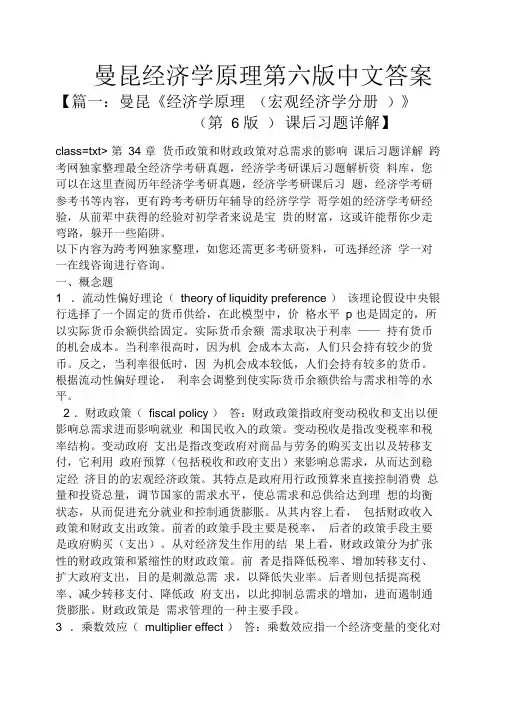
曼昆经济学原理第六版中文答案【篇一:曼昆《经济学原理(宏观经济学分册)》(第 6 版)课后习题详解】class=txt> 第34 章货币政策和财政政策对总需求的影响课后习题详解跨考网独家整理最全经济学考研真题,经济学考研课后习题解析资料库,您可以在这里查阅历年经济学考研真题,经济学考研课后习题,经济学考研参考书等内容,更有跨考考研历年辅导的经济学学哥学姐的经济学考研经验,从前辈中获得的经验对初学者来说是宝贵的财富,这或许能帮你少走弯路,躲开一些陷阱。
以下内容为跨考网独家整理,如您还需更多考研资料,可选择经济学一对一在线咨询进行咨询。
一、概念题1 .流动性偏好理论(theory of liquidity preference )该理论假设中央银行选择了一个固定的货币供给,在此模型中,价格水平p 也是固定的,所以实际货币余额供给固定。
实际货币余额需求取决于利率——持有货币的机会成本。
当利率很高时,因为机会成本太高,人们只会持有较少的货币。
反之,当利率很低时,因为机会成本较低,人们会持有较多的货币。
根据流动性偏好理论,利率会调整到使实际货币余额供给与需求相等的水平。
2 .财政政策(fiscal policy )答:财政政策指政府变动税收和支出以便影响总需求进而影响就业和国民收入的政策。
变动税收是指改变税率和税率结构。
变动政府支出是指改变政府对商品与劳务的购买支出以及转移支付,它利用政府预算(包括税收和政府支出)来影响总需求,从而达到稳定经济目的的宏观经济政策。
其特点是政府用行政预算来直接控制消费总量和投资总量,调节国家的需求水平,使总需求和总供给达到理想的均衡状态,从而促进充分就业和控制通货膨胀。
从其内容上看,包括财政收入政策和财政支出政策。
前者的政策手段主要是税率,后者的政策手段主要是政府购买(支出)。
从对经济发生作用的结果上看,财政政策分为扩张性的财政政策和紧缩性的财政政策。
前者是指降低税率、增加转移支付、扩大政府支出,目的是刺激总需求,以降低失业率。
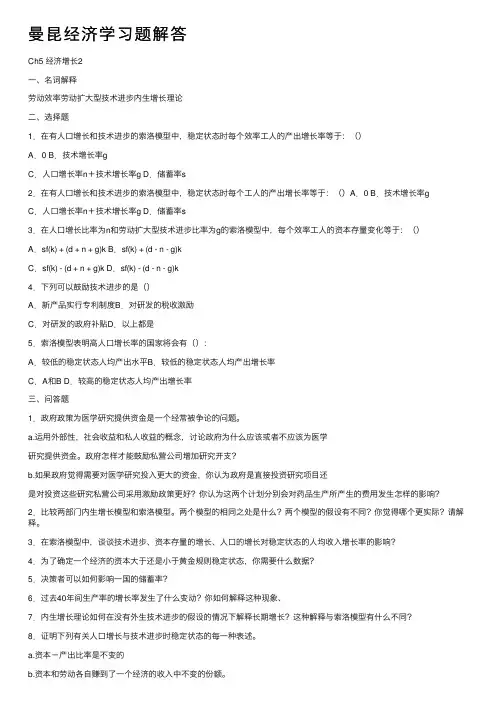
曼昆经济学习题解答Ch5 经济增长2⼀、名词解释劳动效率劳动扩⼤型技术进步内⽣增长理论⼆、选择题1.在有⼈⼝增长和技术进步的索洛模型中,稳定状态时每个效率⼯⼈的产出增长率等于:()A.0 B.技术增长率gC.⼈⼝增长率n+技术增长率g D.储蓄率s2.在有⼈⼝增长和技术进步的索洛模型中,稳定状态时每个⼯⼈的产出增长率等于:()A.0 B.技术增长率gC.⼈⼝增长率n+技术增长率g D.储蓄率s3.在⼈⼝增长⽐率为n和劳动扩⼤型技术进步⽐率为g的索洛模型中,每个效率⼯⼈的资本存量变化等于:()A.sf(k) + (d + n + g)k B.sf(k) + (d - n - g)kC.sf(k) - (d + n + g)k D.sf(k) - (d - n - g)k4.下列可以⿎励技术进步的是()A.新产品实⾏专利制度B.对研发的税收激励C.对研发的政府补贴D.以上都是5.索洛模型表明⾼⼈⼝增长率的国家将会有():A.较低的稳定状态⼈均产出⽔平B.较低的稳定状态⼈均产出增长率C.A和B D.较⾼的稳定状态⼈均产出增长率三、问答题1.政府政策为医学研究提供资⾦是⼀个经常被争论的问题。
a.运⽤外部性,社会收益和私⼈收益的概念,讨论政府为什么应该或者不应该为医学研究提供资⾦。
政府怎样才能⿎励私营公司增加研究开⽀?b.如果政府觉得需要对医学研究投⼊更⼤的资⾦,你认为政府是直接投资研究项⽬还是对投资这些研究私营公司采⽤激励政策更好?你认为这两个计划分别会对药品⽣产所产⽣的费⽤发⽣怎样的影响?2.⽐较两部门内⽣增长模型和索洛模型。
两个模型的相同之处是什么?两个模型的假设有不同?你觉得哪个更实际?请解释。
3.在索洛模型中,谈谈技术进步、资本存量的增长、⼈⼝的增长对稳定状态的⼈均收⼊增长率的影响?4.为了确定⼀个经济的资本⼤于还是⼩于黄⾦规则稳定状态,你需要什么数据?5.决策者可以如何影响⼀国的储蓄率?6.过去40年间⽣产率的增长率发⽣了什么变动?你如何解释这种现象、7.内⽣增长理论如何在没有外⽣技术进步的假设的情况下解释长期增长?这种解释与索洛模型有什么不同?8.证明下列有关⼈⼝增长与技术进步时稳定状态的每⼀种表述。
曼昆《经济学原理(宏观经济学分册)》(第6版)课后习题详解(第30章货币增长与通货膨胀)Born to win 经济学考研交流群<<<点击加入曼昆《经济学原理(宏观经济学分册)》(第6版)第30章货币增长与通货膨胀课后习题详解跨考网独家整理最全经济学考研真题,经济学考研课后习题解析资料库,您可以在这里查阅历年经济学考研真题,经济学考研课后习题,经济学考研参考书等内容,更有跨考考研历年辅导的经济学学哥学姐的经济学考研经验,从前辈中获得的经验对初学者来说是宝贵的财富,这或许能帮你少走弯路,躲开一些陷阱。
以下内容为跨考网独家整理,如您还需更多考研资料,可选择经济学一对一在线咨询进行咨询。
一、概念题1.货币数量论(quantity theory of money)(西北大学2008研)答:货币数量论是关于货币数量与物价水平关系的一种历史悠久的货币理论。
这种理论最早由16世纪法国经济学家波丹提出,现在继承这一传统的是美国经济学家弗里德曼的现代货币数量论。
这一理论的基本思想是:货币的价值(即货币的购买力)和物价水平都由货币数量决定。
货币的价值与货币数量成反比例变动,物价水平与货币数量同方向变动。
这就是说,货币数量越多,货币的价值越低,而物价水平越高;反之,货币数量越少,货币的价值越高,而物价水平越低。
货币数量论还提供了一种对物价水平变动的解释,即认为一个经济体系的物价水平与其货币供应量成正比例变动。
货币数量论以费雪交易方程式为依据,只考虑货币作为交换媒介的作用,而未考虑货币作为价值贮藏的作用。
2.名义变量与真实变量(nominal variables & real variables)答:真实变量是用实物单位衡量的变量,例如数量和实际国民收入;名义变量是用货币表示的变量,例如物价水平和通货膨胀率。
并且认为货币供给的变化不影响真实变量。
3.古典二分法(classical dichotomy)(中国人民大学2004研;西北大学2008研)答:古典二分法指古典模型中将名义变量与真实变量进行理论划分,从而使名义变量不影响真实变量的一种分析方法。
曼昆经济学基础第七版课后题答案1. 超额利润是对企业家才能这种特殊生产要素所付的报酬。
() [判断题]对错(正确答案)2. 规模过大,也可能出现规模不经济,因此,企业应追求适度规模。
() [判断题] 对(正确答案)错3. 基尼系数越大表示收入分配越平均。
() [判断题]对错(正确答案)4. 在完全竞争市场上,只要存在超额利润,就会有竞争者进入这个市场。
()[判断题]对(正确答案)错5. 小明开了一家奶茶店里,雇了一个员工,那么支付给这个员工的工资属于隐成本。
() [判断题]对错(正确答案)6. 在长期中,随着企业扩大其生产设备,它通常先经历规模不经济,然后规模收益不变,最后是规模经济。
() [判断题]对错(正确答案)7. 完全竞争市场由于其产品无差别,竞争最终导致厂商的超额利润为零。
() [判断题]对(正确答案)错8. 管仲提出“仓廪实而知礼节,衣食足而知荣辱”,揭示了人在满足了低层次的生理需求后,才会追求高层次的精神层面的需求。
() [判断题]对(正确答案)错9. 边际效用开始递减,总效用也开始递减。
() [判断题]对错(正确答案)10. 在经营中,短期内如果收益小于总成本,但大于变动成本,可考虑继续经营。
() [判断题]对(正确答案)错11. 一个长期患病失去工作能力的人属于失业者。
() [判断题]对错(正确答案)12. 为保护农业生产者的基本利益,政府一般会有采用支持价格来解决由于供给增加导致市场价格过低的问题。
() [判断题]对(正确答案)错13. 一定程度的失业是不可避免的,因此,失业率不可能降为零。
() [判断题] 对(正确答案)错14. 当消费者的收入发生变化时,会引起需求曲线的移动。
() [判断题]对(正确答案)错15. 消费者剩余会随着消费量的增加而减少,主要原因是边际效用在递减。
() [判断题]对(正确答案)错16. 当你选择了上大学,那么上大学的机会成本就是学费以及如果不上大学用于工作的时间带来的价值。
第一篇导言复习题第一章宏观经济学的科学1、解释宏观经济学和微观经济学之间的差距,这两个领域如何相互关联?【答案】微观经济学研究家庭和企业如何作出决策以及这些决策在市场上的相互作用。
微观经济学的中心原理是家庭和企业的最优化——他们在目的和所面临的约束条件下可以让自己的境况更好。
而相对的,宏观经济学研究经济的整体情况,它主要关心总产出、总就业、一般物价水平和国际贸易等问题,以及这些宏观指标的波动趋势与规律。
应该看到,宏观经济学研究的这些宏观经济变量是以经济体系中千千万万个体家庭和企业之间的相互作用所构成的。
因此,微观经济决策总是构成宏观经济模型的基础,宏观经济学必然依靠微观经济基础。
2、为什么经济学家建立模型?【答案】一般来说,模型是对某些具体事物的抽象,经济模型也是如此。
经济模型可以简洁、直接地描述所要研究的经济对象的各种关系。
这样,经济学家可以依赖模型对特定的经济问题进行研究;并且,由于经济实际不可控,而模型是可控的,经济学家可以根据研究需要,合理、科学的调整模型来研究各种经济情况。
另外,经济模型一般是数学模型,而数学是全世界通用的科学语言,使用规范、标准的经济模型也有利于经济学家正确表达自己的研究意图,便于学术交流。
3、什么是市场出清模型?什么时候市场出清的假设是适用的?【答案】市场出清模型就是供给与需求可以在价格机制调整下很快达到均衡的模型。
市场出清模型的前提条件是价格是具有伸缩性的(或弹性)。
但是,我们知道价格具有伸缩性是一个很强的假设,在很多实际情况下,这个假设都是不现实的。
比如:劳动合同会使劳动力价格在一段时期内具有刚性。
因此,我们必须考虑什么情况下价格具有伸缩性是合适的。
现在一般认为,在研究长期问题时,假设价格具有伸缩性是合理的;而在研究短期问题时,最好假设价格具有刚性。
因为,从长期看,价格机制终将发挥作用,使市场供需平衡,即市场出清,而在短期,价格机制因其他因素制约,难以很快使市场出清。
曼昆《经济学原理(宏观经济学分册)》(第6版)第12篇 短期经济波动第33章 总需求与总供给课后习题详解跨考网独家整理最全经济学考研真题,经济学考研课后习题解析资料库,您可以在这里查阅历年经济学考研真题,经济学考研课后习题,经济学考研参考书等内容,更有跨考考研历年辅导的经济学学哥学姐的经济学考研经验,从前辈中获得的经验对初学者来说是宝贵的财富,这或许能帮你少走弯路,躲开一些陷阱。
以下内容为跨考网独家整理,如您还需更多考研资料,可选择经济学一对一在线咨询进行咨询。
一、概念题1.衰退(recession )答:衰退指收入减少与失业增加较为缓和的经济时期。
一般的衡量标准是国民生产总值连续两个季度下降。
一个完整的经济周期包括繁荣、衰退、萧条、复苏四个阶段。
在繁荣阶段,经济活动全面扩张,不断达到新的高峰。
在衰退阶段,经济在短时间保持均衡后出现紧缩的趋势。
在萧条阶段,经济出现急剧的收缩和下降,很快从活动量的最高点下降到最低点。
在复苏阶段,经济从最低点恢复并逐渐上升到先前的活动量高度,进入繁荣。
2.萧条(depression )答:萧条是真实GDP 严重减少的时期,指商业周期的紧缩阶段。
经济处于萧条阶段时,经济活动远低于正常水平,企业和消费者的严重悲观情绪持续很长的一个时期,它紧接着在达到一个高峰之后,以周期的低谷而告终。
其特点是:生产急剧缩减,资本投资减少,信用规模收缩,价格持续下滑,失业增多,就业水平降低,企业家与消费者的情绪悲观。
在美国历史上曾发生过两次严重的萧条,一次发生在1873~1879年,一次发生在1929~1933年。
政府采取经济政策干预经济的目的在于缩短或消除这种经济萧条。
3.总需求与总供给模型(model of aggregate demand and aggregate supply ) 答:总需求与总供给模型指将总需求与总供给结合在一起来分析国民收入与价格水平的决定及其变动的国民收入决定模型。
曼昆经济学原理答案30—34第十二篇短期经济波动第三十一章总需求与总供给复习题1.写出当经济进入衰退时下降的两个宏观经济变量的名字。
写出当经济进入衰退时上升的一个宏观经济变量的名字。
答:当经济进入衰退时,实际GDP和投资支出下降,失业率上升。
2.画出一个有总需求、短期总供给和长期总供给的曲线的图。
仔细地标出正确的轴。
答:图31—1 经济的长期均衡3.列出并解释总需求曲线向右下方倾斜的三个原因。
答:为了理解总需求曲线向右下方倾斜的原因,我们必须考察物价水平如何影响消费、投资和净出口的物品与劳务需求量。
(1)庇古的财富效应物价水平下降使消费者感到更富裕,这又鼓励他们更多地支出,消费支出增加意味着物品与劳务的需求量更大。
(2)凯恩斯的利率效应较低的物价水平降低了利率,鼓励了家庭和企业更多地支出于投资物品,从而增加了物品与劳务的需求量。
(3)蒙代尔——弗莱明汇率效应当美国物价水平下降引起美国利率下降时,实际汇率贬值,而且这种贬值刺激了美国的净出口,从而增加了国外对美国物品与劳务的需求量。
由于这三个原因,总需求曲线向右下方倾斜。
4.解释为什么长期总供给曲线是垂线。
答:在长期中,一个经济的物品与劳务的供给取决于它资本与劳动的供给,以及用来把资本与劳动变为物品与劳务的生产技术。
由于物价水平并不影响这些实际GDP的长期决定因素,所以长期总供给曲线是一条垂线,即经济的资本、劳动和技术决定了物品与劳务供给量,而且,无论物价水平如何变动,供给量都是相同的。
5.列出并解释为什么短期总供给曲线向右上方倾斜的三种理论。
答:在短期中,总供给曲线向右上方倾斜,也就是说,在一个一两年的时期中,经济中物价总水平的上升增加了物品与劳务的供给量,而物价水平下降倾向于减少物品与劳务供给量。
什么因素引起物价水平与产量之间的正相关关系呢?宏观经济学家提出了三种理论说明短期总供给曲线的向右上方倾斜。
在每一种理论中,一种特殊的市场不完全性引起经济中供给一方的短期状况与长期不同。
虽然每一种理论在细节上不同,但它们具有共同的内容:当物价水平背离了人们预期的物价水平时,供给量就背离了其长期水平或“自然水平”。
当物价水平高于预期水平时,产量就高于其自然率。
当物价水平低于预期水平时,产量就低于其自然率。
(1)新古典的错觉理论根据这种理论,物价总水平的变动会暂时误导供给者对他们出售其产品的市场发生的变动的看法。
由于这些短期的错觉,供给者对物价水平的变动作出了反应,而这种反应引起了向右上方倾斜的总供给曲线。
假设物价总水平降到低于预期水平,当供给者看到他们产品的价格下降时,他们可能会错误地认为,他们的相对价格下降了,这些错觉引起供给者对较低物价水平的反应是减少物品与劳务的供给量。
(2)凯恩斯主义的粘性工资理论根据凯恩斯和他许多追随者的看法,短期总供给曲线向右上方倾斜是因为名义工资调整缓慢,或者说在短期中是“粘性的”。
在某种程度上,名义工资调整缓慢是由于工人和企业之间固定名义工资的长期合约,有时这种长期为3年。
设想企业根据所预期的物价水平事先同意向其工人支付某种名义工资。
如果物价水平户降到低于预期的水平而名义工资(W)仍然在原来的水平上,那么实际工资(W/F)就上升到企业计划支付的水平之上。
由于工资是企业生产成本的主要部分,较高的工资意味着企业的实际成本增加了,企业对这些较高成本的反应是少雇佣劳动,并生产较少的物品与劳务量。
换句话说,由于工资不能根据物价水平迅速调整,较低的物价水平就使就业与生产不利,这就引起企业减少物品与劳务的供给量。
(3)凯恩斯主义的粘性价格理论根据这种理论,一些物品与劳务的价格对经济状况变动的调整也是缓慢的。
这种价格的缓慢调整的产生,部分是因为调整价格有成本,即所谓的菜单成本。
这些菜单成本包括印刷和分发目录的成本和改变价格标签所需要的时间。
由于这些成本,短期中价格可能都是粘性的。
假设经济中每个企业都根据它所预期的经济状况事先宣布了它的价格。
在价格宣布之后,经济经历了未预期到的货币供给紧缩,这将降低长期的物价总水平。
虽然一些企业根据经济状况的变动迅速降低了自己的价格,但还有一些企业不想引起额外的菜单成本,因此暂时不调整价格。
由于这些滞后,企业价格如此之高,所以它们的销售减少了,销售减少了又引起企业削减生产和就些。
换句话说,由于并不是所有价格都根据变动的状况而迅速调整,未预期到的物价水平下降使一些企业的价格高于合意水平,而这些高于合意水平时价格压低了销售,并引起企业减少它们生产的物品与劳务量。
所有这三个理论都表明,当物价水平背离人们预期的物价水平时,产量就背离其自然率。
6.什么因素引起总需求曲线向左移动?用总需求和总供给模型来探讨这种移动的影响。
答:图31—2 总需求减少的影响总需求曲线向左移动表示总需求减少,原因可能是白宫丑闻、股票市场崩溃或者国外爆发了战争。
由于这些事件,许多人对未来失去信心并改变了他们的计划。
家庭削减他们的支出,并延迟了主要购买,而企业也放弃了购买新工厂。
这些事件减少物品与劳务的总需求。
如图所示,总需求曲线向左从AD,移动到AD:。
在短期中,经济沿着原来的短期总供给曲线AS,,从A点变动到B点。
随着经济从A点移动到月点,产量从Yl下降到丫2,而物价水平从尸1下降到户:。
7.什么因素引起总供给曲线向左移动?用总需求和总供给模型来探讨这种移动的影响。
答:设想一个经济处于长期均衡,现在突然一些企业经历了生产成本增加,例如,农业州的坏天气会摧毁一些农作物,使生产农产品的成本上升,或者中东的一场战争会中断原油运输,使生产石油产品的成本上升。
这种生产成本的增加会使在任何一种既定物价水平时,企业想供给的物品与劳务量少了。
如图所示,短期总供给曲线向左从AS,移动到AS20在短期中,经济沿着现在的总需求曲线移动,从A点到月点。
经济的产量从Y1减少为y:,而物价水平从尸1上升到P:。
由于经济既经历了产量下降(停滞)又经历了物价上升(通货膨胀),所以这个事件有时被称为滞胀。
图31—3 总供给减少的影响问题与应用1.为什么你认为经济周期中投资的变动比消费支出大?你认为消费支出中哪一类变动最剧烈:耐用品(例如家具和汽车购买),非耐用品(例如食物和衣服),还是劳务(例如理发和医疗保健)?为什么?答:我认为经济周期中投资的变动比消费支出大,因为投资的价格弹性和收入弹性都大于消费的价格弹性和收入弹性,因而经济周期中投资的变动比消费支出大。
据调查,尽管平均而言投资只占GDP的七分之一,但衰退期间投资的减少引起了三分之二的GDP减少。
我认为消费支出中耐用消费品的变动最剧烈,因为耐用消费品的价格需求弹性和收入需求弹性都要高于非耐用品和劳务的价格需求弹性和收入需求弹性。
2.假设经济由于总需求减少发生了衰退。
A.用总需求与总供给图表示现在的经济状况。
答:图31—4 总需求减少的影响B.失业率发生了什么变动?答:失业率上升。
C.“资本设备利用率”衡量资本存量被利用的程度。
在衰退中,资本设备利用率高于还是低于其长期平均水平?并解释之。
答:在衰退中,资本设备利用率是低于其长期平均水平。
因为衰退期间,产量减少,失业增加,资本设备的利用率下降,会低于其长期平均水平。
3.解释下面每一个事件是使长期总供给增加、减少,还是没有影响?A.美国经历了移民高潮。
答:美国经历了移民高潮会使美国的长期总供给增加,因为人力资本存量的增加提高了生产率,从而增加了增加物品与劳务的供给量,结果,长期总供给增加。
B.国会把最低工资提高到每小时10美元。
答:当国会把最低工资提高到每小时10美元时,自然失业率就会上升,而且经济中生产的物品与劳务量会减少。
结果长期总供给减少。
C.英特尔公司投资于新的、更强劲的电脑芯片。
答:英特尔公司投资于新的、更强劲的电脑芯片使劳动生产率提高,结果长期总供给增加。
D.严重的暴风雨危及东海岸的工厂。
答:严重的暴风雨危及东海岸的工厂会影响美国东海岸工厂的正常生产能力,损坏这些工厂的设备、厂房等资本存量,经济中生产的物品与劳务会减少,结果美国的长期总供给会减少。
4.在图3l—8中,与A点失业率相比,B 点和C点的失业率是多少?根据粘性工资对短期总供给曲线的解释,与A点的实际工资相比,B 点和C点的实际工资是多少?答:与A点的失业率相比,月点的失业率高于A点,C点的失业率和A点的失业率都是自然失业率。
根据粘性工资对短期总供给曲线的解释,与A点的实际工资相比,B点的实际工资上升,C点的实际工资未变。
5.解释为什么以下说法是错的。
A.“总需求曲线向右下方倾斜是因为它是个别物品需求曲线的水平相加。
”答:总需求GDP(y)二消费(C)十投资(/)+政府购买(G)+净出口(NX),由于政府购买是一个固定的政策变量,而其他三个组成部分——消费、投资和净出口取决于经济状况,特别是物价水平。
(1)当物价水平下降时,消费者感到更加富裕,这会鼓励他们更多地支出。
(2)较低的物价水平降低了利率,鼓励了企业和家庭更多地支出于投资物品,从而增加了物品与劳务的需求量。
(3)当美国物价水平下降引起美国利率下降时,实际汇率贬值,而且,这种贬值刺激了美国的净出口,从而增加了物品与劳务的需求量。
由于这三个原因,总需求曲线向右下方倾斜。
B.“长期总供给曲线垂直是因为经济力量并不影响长期总供给。
答:在长期中,一个经济的物品与劳务供给取决于它资本与劳动的供给,以及用来把资本与劳动变为物品与劳务的生产技术。
由于物价水平并不影响这些实际GDP的长期决定因素,所以长期总供给曲线是一条垂线。
C.“如果企业每天调整自己的价格,那么,短期总供给曲线就是水平的。
”答:如果企业每天调整自己的价格,那么,短期总供给曲线就是垂直的。
企业不会由于物价水平上升,会认为相对价格水平上升而增加供给,因此总供给总是处于自然状态。
D.“只要经济进入一次衰退,它的长期总供给曲线就向左移动。
”答:只有经济中改变自然产量率的变动才会使长期总供给曲线移动。
当经济进入一次衰退,在既定的物价水平时,经济的总需求下降,它只会移动短期总供给曲线,而不会使长期总供给曲线向左移动。
6.根据短期总供给曲线向右上方倾斜的三种理论中的每一种理论,认真解释以下的情况:A.在没有任何政策干预时,经济如何从衰退中复苏,并回到其长期均衡。
答:当经济陷入衰退时,经济中物价水平下降,当供给者看到他们产品的价格下降时,他们可能会错误地认为是他们的相对价格下降了,因此他们会减少物品与劳务的供给量。
当物价水平下降而名义工资仍然不变,那么实际工资就会上升到企业计划支付的水平之上。
由于工资是企业生产成本的主要部分,较高的实际工资意味着企业的实际成本增加了,企业对这些较高成本的反应是减少劳动雇佣量,因此较低的物价水平使企业减少了物品与劳务的供给量。